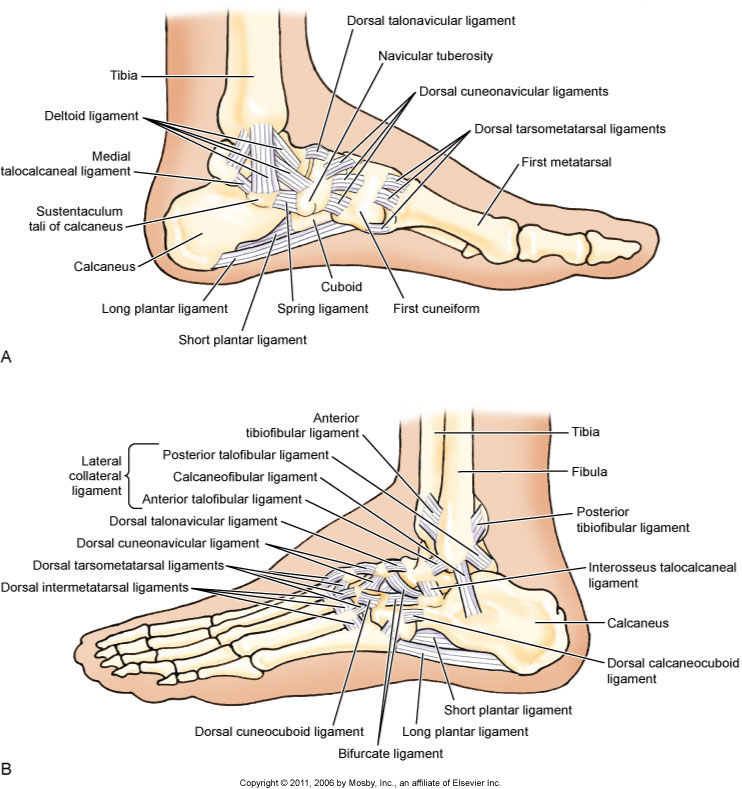Introduction to ankle sprain:

Medial and lateral views of the ligaments of the ankle joint. Permission: Joseph E. Muscolino. Kinesiology: The Skeletal System and Muscle Function (Elsevier), 2017.
The ankle joint is located between the talus and the distal ends of the tibia and fibula. It is a uniaxial joint that allows only sagittal plane (or near sagittal plane) motions of dorsiflexion and plantarflexion. Frontal and transverse plane motions of the foot do not occur at the ankle joint, rather they occur at the subtalar joint (located between the talus and calcaneus).
An ankle sprain is a traumatic injury that results in tearing of ligaments of the joint. The ankle is the most commonly sprained joint in the human body; and the most common type of ankle sprain is an inversion sprain in which ligaments on the lateral side of the ankle joint are overstretched or torn. As with all joint sprains, ankle sprains are usually divided into three categories based on the degree of severity: Grade 1 is a mild sprain; Grade 2 is a moderate sprain; and Grade 3 is a severe sprain or complete rupture.
Causes:
The cause of an ankle joint sprain is motion that is beyond the normal range of motion of the joint. At the end of range of motion, ligaments are pulled taut, trying to stabilize the bones and prevent dislocation. If the motion is excessive, the ligaments can be overstretched and torn.
By far, the most common type of ankle joint sprain is when the foot moves excessively into inversion. Foot inversion occurs at the subtalar joint, but if the range of inversion exceeds the subtalar joint’s ability to invert, the tensile pulling force of inversion will then be experienced at the ankle joint itself. If this motion is strong enough, it will exceed the ability of the laterally placed ligaments of the ankle joint to restrain inversion and they will be overstretched and torn. These three lateral ligaments are the anterior talofibular, calcaneofibular, and posterior talofibular ligaments. As their names imply, the anterior talofibular ligament is located the most anteriorly; the posterior talofibular ligament is located the most posteriorly, and the calcaneofibular ligament is in the middle between the other two.
Ankle sprains usually occur due to stepping on uneven ground, resulting in the foot falling into inversion. Because inversion sprains usually occur when a person is walking or running, the momentum of body weight moving forward often results in not only inversion of the foot, but also plantarflexion. This focuses the tension force of the stretch to the more anteriorly located anterior talofibular ligament. Indeed, the anterior talofibular ligament is the most commonly sprained ligament in the human body.
A further causative factor of ankle joint inversion sprain is laxity (“weakness”) of the lateral ligaments of the ankle joint. Ironically, once the ankle joint has been sprained into inversion, because the sprain results in overstretching/tearing of the lateral ligaments, they become more lax and less able to prevent ankle joint inversion in the future. Therefore, once a client/patient has experienced an inversion sprain of the ankle joint for the first time, it is more likely that further inversion sprains will occur in the future. Each successive sprain further weakens the ligaments, further increasing the susceptibility of the joint to continuing inversion sprains.
Similarly, weak musculature can also contribute to the occurrence of ankle sprains. Musculature can assist ligaments in restraining excessive motion at a joint. If the eversion muscles of the foot are weak, they are less able to limit inversion, increasing the likelihood of an inversion sprain. The muscles of eversion are the fibularis longus, brevis, and tertius, and the extensor digitorum longus. (The fibularis muscles were formerly known as the peroneus muscles.)
Note: It is extremely rare for the ankle joint to be sprained into eversion because the lateral malleolus of the fibula extends farther distally than the medial malleolus of the tibia, limiting eversion range of motion compared to inversion. Another factor that limits eversion is the ligament structure of the ankle joint. The ligament complex on the medial side of the ankle joint is stronger than the ligament complex on the lateral side. This further limits foot eversion, making an eversion sprain even less likely.


